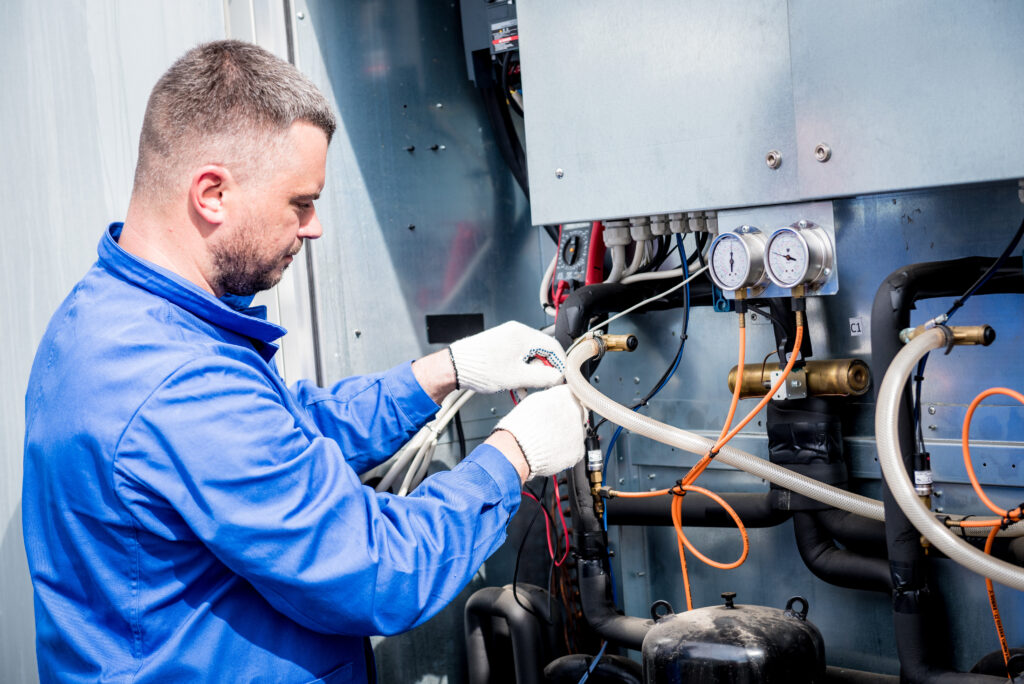
No matter what time of year it is, no one wants to deal with a broken HVAC. But it can be especially brutal in the summer when you’re relying on the A/C to keep everyone inside the building cool and comfortable. If you have equipment or products that are sensitive to temperature fluctuations or humidity, they could be at risk as well.
When your HVAC system stops working, there’s no time to waste. Below is an action plan you can use to troubleshoot the source of the issue, mitigate the effects, and get an HVAC pro on site to get things up and running ASAP.
What to Do When Your HVAC Isn’t Working: Action Plan
There are a number of things that can go wrong with HVAC systems. For example:
- Antiquated equipment
- Dirty filters or condenser coils
- Broken ignition
- Dead thermostat batteries
- Thermostat system failure
- Water, refrigerant, or duct leak
- Busted blower mower
It’s not always easy to tell what’s causing the problem from the outside. However, if you’ve determined that the issue is severe and not just a temporary circuit breaker or power outage, here’s what you need to do:
1. Check the Thermostat
The first place to go is your thermostat. See if the temperature accurately reflects what it’s supposed to be or what it actually feels like. If it doesn’t, try adjusting it.
If the thermostat is blank or unresponsive to your input or an error message appears, then there’s likely something wrong with the unit.
2. Listen to Your HVAC Equipment
Turn your attention to your HVAC equipment next.
If the system is still running, take a few moments to listen to it. Faulty equipment can make clicking or buzzing noises. Or you might hear the system quickly turn on and off in rapid succession, like it’s struggling to work.
3. Contact an HVAC Contractor
Whether you have an idea of what may be wrong or you’re still completely in the dark, you should contact an HVAC professional. They’ll be able to give your equipment a thorough inspection to find the root cause and then give you an estimate and timeline to fix it.
4. Gather Info
In addition to taking down your observations regarding the thermostat and the HVAC equipment, document the situation at hand:
- When did the problem start?
- Is it consistent or does it only happen some of the time?
- What is the extent of the problem? Are only some parts of the building impacted?
Also, gather all the information related to your HVAC system. If you have a warranty, make sure you’ve reviewed it and have a copy of it on hand. If you’ve had recent maintenance or repairs done, track down a copy of the report and invoice, too.
5. Inform Tenants About the Situation
Don’t leave your building’s tenants or employees hanging. They’re probably experiencing as much stress as you are in addition to the discomfort of working in a space without proper heating, cooling, or ventilation.
Send out a mass email or text to let them know the steps you’re taking and give them an ETA on when it will be fixed. If needed, adjust operating hours or relocate people to another building.
6. Implement a Temporary Fix
Even if you have a professional coming to check things out and perform repairs, things may get very uncomfortable for anyone within the building. Until help arrives, you can do things like:
- Open the windows and doors to improve ventilation.
- Place box or floor fans in high-capacity rooms.
- Rent air conditioners, spot coolers, or chillers.
Temporary relief will go a long way in keeping everyone happy until the HVAC is up and running properly.
What’s Next?
Extended HVAC outages and inefficient equipment can be quite costly. Not just in terms of repairs, but in terms of how your handling of the situation affects your relationship with the people working, visiting, or living on the premises.
When your building’s HVAC stops working, it’s critical that you have an action plan ready to go. By taking swift action, you can minimize downtime and the overall cost of such an emergency.
Another thing to do is ensure you have a trusted HVAC provider you can call. Having someone who is familiar with your setup will save you a ton of time and headaches when your system starts acting up.
If you’re in the Wichita area and you’re looking for an HVAC contractor, give us a call at 316-688-1901 and tell us what you need.
